

3 Ways to Use Video Conferencing with Students Learning Remotely. Five Norms and Five Rubrics for High-Quality Online Learning. Online learning is now a permanent part of school life.

The COVID-19 pandemic forced schools to move online quickly, with little preparation. As weeks and months passed, two things became clear: 1) an “emergency” approach to online learning was not sustainable or advisable and 2) schools needed clarity and guidance in defining and designing for high-quality online learning. The issue of quality is an important one. After several months of doing their best in a crisis, schools now face higher expectations from students, their families, and teachers about how to design, deliver, and support online learning.
Defining what online learning should look like in terms of core elements like relationships, rigor, assessment, and the roles of students and teachers is the first step in ensuring learners have the best, most meaningful experience possible. 8 Ideas Designed to Engage Students In Active Learning Online. I’ve spent the last four months working with teachers all over the country (virtually, of course) as they navigate the uncharted waters of online and blended learning.
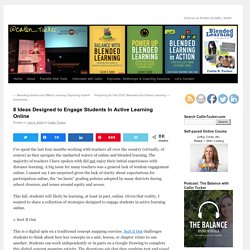
The majority of teachers I have spoken with did not enjoy their initial experiences with distance learning. A big issue for many teachers was a general lack of student engagement online. I cannot say I am surprised given the lack of clarity about expectations for participation online, the “no harm” grading policies adopted by many districts during school closures, and issues around equity and access.
This fall, students will likely be learning, at least in part, online. Given that reality, I wanted to share a collection of strategies designed to engage students in active learning online. 1. This is a digital spin on a traditional concept mapping exercise. COVID-19 as a catalyst for educational change. Many areas of schooling in educational institutions can be and should be rethought.
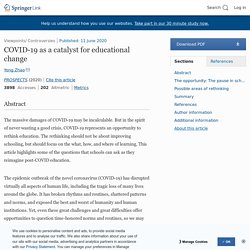
Newsletter. Teacher as Activator tips for remote learning. Leaning Into The Innovation Opportunity. School and system leaders have about two months to make four important decisions about the future of school: how to blend digital content into the core, link it to an updated plan for remote learning, plan for super hygiene and distancing onsite, and starting (or partnering with) an online school.
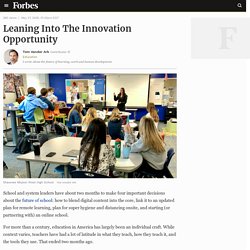
For more than a century, education in America has largely been an individual craft. While context varies, teachers have had a lot of latitude in what they teach, how they teach it, and the tools they use. That ended two months ago. In what is likely to be the most challenging ever, next year will make clear that education is a team sport—collaboration and flexibility around common tools, resources, and teaching strategies will be critical to meet dynamic conditions and student needs this fall.
Building on the important decisions for next year, there are three innovation opportunities focusing on the success skills of thriving humans. 1.Thriving Humans. Students want to be seen, heard and valued. Shining the Competency Education Light on Education in the Time of Covid19. Has Covid19 lifted the window of opportunity for a massive transformation of the education system?
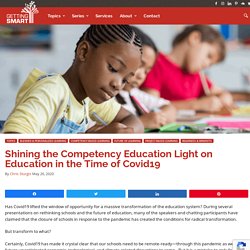
During several presentations on rethinking schools and the future of education, many of the speakers and chatting participants have claimed that the closure of schools in response to the pandemic has created the conditions for radical transformation. But transform to what? Certainly, Covid19 has made it crystal clear that our schools need to be remote-ready—through this pandemic as well as for future unanticipated economic, technological, and climate-related disruptions to come. But it is a mistake to only focus on the technology and online instruction alone. Entrevista a Francesco Tonucci. Ante la situación excepcional que estamos viviendo a causa de la pandemia, el pensador, psicopedagogo y dibujante italiano, Francesco Tonucci aboga por la introducción de cambios profundos en la escuela que estén encaminados a “desarrollar su personalidad (de los niños), sus aptitudes y su capacidad mental y física hasta el máximo de sus posibilidades”, según el artículo 29 de la Convención de los Derechos de la Infancia de 1989.
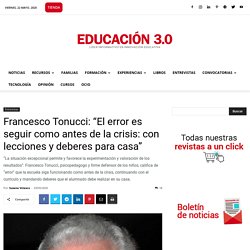
¿La pandemia que estamos viviendo marcará un antes y un después para la Educación? Depende de cómo valoren, cada uno de los protagonistas de la educación escolar, su trabajo actual y el funcionamiento de la escuela. ¿Cómo desarrollar la perseverancia de los estudiantes en la escuela? – Las preguntas educativas. Building the Future Now: Deciding What to Cut, What to Keep and What to Create - Learning Personalized. By Heidi Hayes Jacobs and Allison ZmudaPart Two in a Four-Part Series As the school year is winding to a close and everyone is desperate for a break, looking toward the opening of school next year is already causing unease.
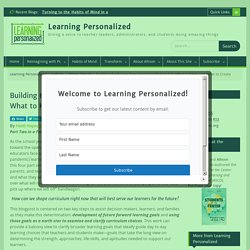
Throughout the world, educators face a critical challenge: how to design aspirational and future forward (post-pandemic) learning experiences rather than a temporary fix (triage). In our first blogpost in this four part series, we proposed the importance of beginning with input from students, parents, and teachers about what they are experiencing, what lessons they are learning, and what they will need moving into the next school year. We also looked at factors to mull over what will matter most in the planning for the year rather than jumping onto the “let’s pick up where we left off” bandwagon. Choose Your Own Learning – 4 Learning Options As We Go Virtual/Online. Note: Yes, you may adapt this to fit your own needs, but please give credit and also do not adapt it to sell it online or in any way benefit financially beyond your salary as an educator.
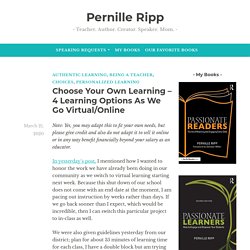
In yesterday’s post, I mentioned how I wanted to honor the work we have already been doing in our community as we switch to virtual learning starting next week. Because this shut down of our school does not come with an end date at the moment, I am pacing out instruction by weeks rather than days. If we go back sooner than I expect, which would be incredible, then I can switch this particular project to in-class as well.
We were also given guidelines yesterday from our district; plan for about 35 minutes of learning time for each class, I have a double block but am trying to keep it to around that time still, instead with the extra time, I am hoping kids will find the time to read. Kids are not expected to sit in front of a computer all day. Choice 1: The independent reading adventure. Like this: Videoteca Think1.tv. John Spencer. Genially. Does it Work? The Most Meaningless Question to Ask about Online Education. An extended version of this post will be published in the journal of ECNU Review of Education.
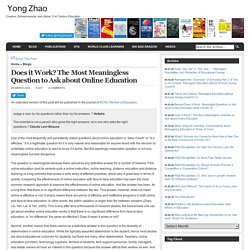
Judge a man by his questions rather than by his answers. ? VoltaireThe scientist is not a person who gives the right answers, he’s one who asks the right questions.? Clases online: claves para la correcta planificación. Dadas las circunstancias en las que nos encontramos los docentes, nos vemos obligados a adaptar nuestros contenidos al formato digital.
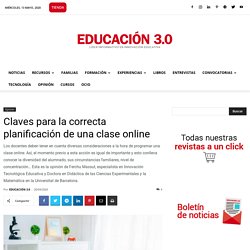
Es en ese preciso momento cuando nos encontramos con diferentes limitaciones. Una de ellas es la cantidad de contenido que podemos trabajar cada semana con los alumnos, pues tenerlo claro nos permitirá planificar los días y posteriormente enfrentarnos al resto de desafíos tecnológicos. Mastery Transcript Consortium: Re-inventing how students prepare for college, career, and life. Activity Guides for Changemaking at Home. "No me interesa cómo evaluar las competencias, me interesa cómo la evaluación ayuda al desarrollo de las competencias, The Blending of Space and Time During COVID-19. The coronavirus (COVID-19) crisis and the necessity of the use of EdTech for remote learning will blend, bend, and alter the new norm for education systems as they reimagine space and time.
EdTech has always promised anytime, anywhere learning and we are currently seeing the challenges and opportunities of this mode of learning. While education systems deal with emergency responses to the crisis, they are also laying the seeds for future recovery, resilience and reform of the system. Distance learning solutions. More on UNESCO's COVID-19 Education Response The list of educational applications, platforms and resources below aim to help parents, teachers, schools and school administrators facilitate student learning and provide social care and interaction during periods of school closure. Most of the solutions curated are free and many cater to multiple languages.
While these solutions do not carry UNESCO’s explicit endorsement, they tend to have a wide reach, a strong user-base and evidence of impact. They are categorized based on distance learning needs, but most of them offer functionalities across multiple categories. Resources to provide psychosocial support. How to Teach at Home. With students at home because of the coronavirus threat, social media feeds filled up with color-coded learning schedules from well-meaning parents.
But they’ve struggled to implement those schedules—partly because the tightly structured, time-in-seat approach of traditional schools often has more to do with crowd control than optimizing learning. The sudden shift to work-from-home might provide a good kind of disruption, opening up a golden opportunity for students to engage in authentic, deep learning that is more self-directed, more playful, more aligned with young students’ development—and much easier for parents to manage than stacks of worksheets. Giving students some choice over their learning builds intrinsic motivation, independence, and creativity. Comunicación y Colaboración en entornos remotos de enseñanza #dalelavuelta… Gracias a @tguaschp y @annaespasa por el webminar sobre #feedback en #DocenciaNoPresencialDeEmergencia @UOCuniversitat .Por si ayudan, van tres infografías #dalelavuelta… Ensuring Student-Centered Opportunities for All Students. I trust it is the hope of every principal that the educational debt Ladson-Billings refers to is resolved at the end of each academic year and that all students have achieved equitable learning outcomes.
But as we know, academic outcomes are not enough. Schools are expected to educate the whole child too, as evident in ASCD’s Whole Child Initiative from 2007. As a principal of an urban school and a doctoral candidate at Northeastern University, I have fully adopted student-centered learning as a framework to not only increase the academic progress of students but to also empower them. How to Reopen Schools: A 10-Point Plan Putting Equity at the Center. With nearly all U.S. school buildings closed for the year, teachers and leaders have scrambled to support remote learning and respond to the emerging needs of 57 million elementary and secondary students.
As challenging as it is today, it’s time to begin planning for next year. The damage the pandemic has already caused, its lingering health concerns, and the potential for resurgence make preparation to reopen a complex but urgent affair. “We have both a historic opportunity and an obligation to create approaches to reopening schools that work for all groups of students all of the time, not just some groups of students some of the time,” writes Russlynn Ali, co-founder, and CEO of the XQ Institute. Educar en tiempos de Covid-19. ¿Qué nos dice la Neurociencia? The LEGO Foundation sur Twitter : "Project-based learning designs learning around a meaningful project with scaffolding provided by parents or teachers. Find tips on how this can be done at home from @BoStjerne in this video (1:2) Connections Matter in Lee’s Summit: Planning and Adapting to Virtual Learning. By: Jennifer Kephart As our district began to hear the news of the potential school closures we started shifting our mental models to the care and connection we needed to have with our students and staff through the impending uncertain, uncharted time.
As district leaders, we did what we do best and we met. What we intend on doing for Weeks 1 & 2 this coming Term. (Our Remote Learning Policy - Mk 2). School Leadership During a Crisis. 10 Design Challenges for Children To Help Create Positive Feelings During COVID-19. ¿Se puede seguir usando el ABP o el cooperativo en Primaria? Es evidente que la educación ha sufrido una transformación radical: el espacio ha cambiado, las relaciones entre el alumnado y profesores se han visto modificadas, la distribución de los contenidos ha variado, la comunicación con las familias… Nos hemos visto obligados a realizar una transición excesivamente rápida hacia el aprendizaje en línea y a buscar nuevas formas de que nuestros alumnos y alumnas aprendan.
Afortunadamente, tanto la educación presencial como digital puede enmarcarse dentro del mismo diseño del proceso de aprendizaje. En primer lugar, tengo que conocer qué quiero que mis alumnos aprendan. ¿Cómo mejorar la evaluación de mis estudiantes? Durante estos días de las cuestiones más demandadas por los docentes y las familias es el relativo a los sistemas de evaluación. Las evaluaciones son una parte habitual del proceso de aprendizaje, independientemente de la materia o nivel en el que estemos trabajando y del sistema (presencial, remoto o mixto) que empleemos. Las diseñamos “en todas las formas y tamaños”, y pueden ser utilizadas para lograr distintos objetivos. ¡ABP online! ¿Es posible? En este tiempo de crisis, los docentes nos hemos vuelto a redefinir. La mayoría, sin quererlo, se ha encontrado, de sopetón, que tiene que gestionar aulas que ya no son físicas, sino que están en la red. ¿Cómo realizar el seguimiento de proyectos desde casa? Es posible que esta situación excepcional que vivimos, nos haya sorprendido con un proyecto de aula iniciado o próximo a empezar.
PBLWorks sur Twitter : "What is the quality of thinking in your Project Based Learning Classroom? @MyTLee3 wrote a resource laden blog with great ideas to help! A PBL Culture of Thinking: Routines - #BuildPBLCulture #PBteaching #PB. ¿Cómo trabajo con mis alumnos/as en digital? □ Aquí lo explico. Abro hilo ⬇️ #YoMeQuedoEnCasa #SOSDigitalDocente #elcolesigue… A Message for PBL School Leaders During the Pandemic & School Closures. Time for Change: The Essence of Deep Learning.